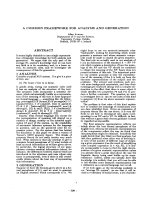A Conceptual Approach for Cannibalism Between Goods pot
Bạn đang xem bản rút gọn của tài liệu. Xem và tải ngay bản đầy đủ của tài liệu tại đây (362.2 KB, 5 trang )
1
A Conceptual Approach for Cannibalism Between Goods
Mauro Laruccia, Universidade Braz Cubas (Brasil),
Sandra Maria Correia Loureiro, University of Aveiro (Portugal),
Rui Lopes, University of Aveiro (Portugal),
Abstract
The launching of a new product is an essential strategy for the survival and success of a
company. However, in certain cases, it can reduce the results obtained by another product of
the same company. This fact is named cannibalism. Following a review of the literature on
cannibalism between goods, this paper outlines a conceptual approach, showing the way it
happens, its impacts and the possibility of its uses as a marketing tool. A new product should,
wherever possible, be carefully designed to avoid cannibalizing old products, unless this
process is carefully planned.
Keywords: cannibalism, new products, marketing.
Introduction
Among the business strategies of competitive organizations can highlight the
continued development and launch of new products, which occurs by the need to replace a
product that no longer provides important benefits to your target audience and the company.
Organizations therefore need a continuous flow of development and introduction of new
products in markets where they choose to act.
According Clancy and Shulman (1993), in the area of consumer packaged goods the
failure rate of new products is estimated at about 80%, and most of these are composed of line
extensions.
Kotler (1998), Semenik and Bamossy (1995), Ries and Trout (2000) and Boone and
Kurtz (2009), when claiming the extension of product line or introducing new products, warn
about the risks of cannibalism. Although they believe that cannibalism is an occurrence that
can divert business from achieving its goals, therefore, considered a problem that must be
controlled, few discuss the causes, consequences, or your dealings with marketing variables.
Thus, this study proposes to meet cannibalism among products.
Cannibalism in Marketing
A product line is very small it can increase profits by adding an item to it, and very
large it can increase profits by removing items. That is, there would be no reason to keep
products that bring harm or do not contribute significantly to the company's profit. However,
this financial approach excludes other important goals of marketing: customer satisfaction,
image, market share, leverage other products, customer loyalty etc. (Kotler, 1998).
Cannibalization of products is the process by which a new product gets a share of sales
by deviation an existing product. Kerin et al (1978) describes the following definition:
“[w]hile product line extension or repositioning strategies pose minimal risk of failure for
product being introduced, potential negative effects on existing products serving existing
2
markets must be considered. These effects can called product cannibalism”. A similar
definition is stated by Traylor (1986): cannibalism occurs when sales of a product from a
company reduces sales of other. Traylor notes that cannibalism is a problem faced primarily
by companies that use multi-brand strategies, since the risk of cannibalism increases as they
seek better definitions of new market segments. Therefore, the excessive division of a given
market decreases the difference between segments, contributing to the process of
cannibalization, since products targeted to a particular segment can attract the public of
another segment. However, one can also believe that other brand strategies can contribute to
the occurrence of cannibalism, depending on the product and target audience to whom it is
directed and does not seem therefore that the brand policy alone is capable of causing or
preventing their occurrence.
Copulsky (1976) states the “cannibalism result from too close identification of a new
product with the launching company’s older products and established markets. New appeals
to new market segments will avoid eating one’s own market share”. Heskett in Kerin et al has
been defined cannibalization as “the process by which a new product gains a portion of its
sales by diverting them from an existing product”.
There are, according Traylor (1986), two ways to understand cannibalism: with vision
focused on the product when a company offers two or more similar products, and market-
oriented view, when two or more products of a company competing in the same segment.
Kerin et al. (1978) remember that sales a new product is coming from sources like new
customers, consumers of similar products of competitors and consumers of products like the
company itself. We can observe that the last of these sources is who triggers cannibalism.
Thus, cannibalism may be understood as an appropriation that a new product is part or
all of sales, the sales volume (quantity) of market share, the profits, the spaces intended for
distribution channels and / or customer loyalty that normally occur to one or more existing
products from the same company (Oliveira, 2000, p.5). It can be observed cannibalism and its
different forms of existence in the four these figures. For a proper understanding of the
figures, it should be understood by the competing product sum of the products of competitors
targeting the same market segment, and the old product, the products targeted at this segment,
belonging to the company that is introducing the new product. The circles represent the sales
of products (without scale, just to clarify the ideas described) and the intersections between
competing product - new and old should be understood as part of business performance for
both floating, i.e.| one that also affected of promotional tools, typically reaching consumers
who have little loyalty towards a brand or company (Traylor, 1986).
Models of Marketing Cannibalism
The model 1 (see Figure 1) shows a new product introduced by the company that had
an old product with an equivalent position. Old product sales cannibalized in the same extent
that increased the new product. It is the most dangerous form of cannibalism, because there
are no increases in sales, but can be tolerated if the new product is more profitable than the
old one. Model 2 shows a cannibalism with less intensity than the one shown in Figure 1,
because the new product cannibalize part of the old product (which may be greater or lesser
degree) and creates an expanding market where the company operates. This expansion of the
market, despite the occurrence of cannibalism, can occur by different attributes that the new
product features, and by position strategies differently than the old product of the same
company.
3
A third choice of cannibalism, shown in model 3 is the occurrence in one part of the
old product and a part of a competing product (from another company) also creates a market
expansion. It is a situation of greater risk than before, considering that the new product can
experience a counterattack from the competition.
In model 4, we can see other cannibalism possibility that acts on the company that
owns the new product and in competition, with no expansion of the consumer market,
presenting, therefore, as a situation of greater risk the last one. Currently, presumed private
label brands account for a significant share of sales of retailers, particularly in the area of
food. The growth in size and share of own brands can stimulate the development of
cannibalism among products, as these produced by industries that have other products on the
market with brands of their property and that, attracted by the opportunity to optimize their
resources, propose to produce goods exclusively for certain retailers. Once producers do not
normally perform the management of these products, but the retailers for which they offer can
cannibalize the products cannibalized by this private label and vice versa, this phenomenon
called indirect cannibalism.
A second form of indirect cannibalism, but that does not include other companies, is
one that occurs with a company's products, as new products developed by a company, we
believe there is cannibalism of time and attention of salespeople, managers' products,
production and distribution, which can be called pre-cannibalism or institutional cannibalism.
In some cases, production can be cannibalized, considering the possibility of a single plant to
create different product items.
Model 1. New product introduced by
the company that had an old
product
Model 2. Cannibalism with less
intensity
Model 3. Cannibalism in one part
Model 4. Cannibalism on the
company
Figure 1: Models of cannibalism
Source: Adapted from Traylor (1986).
4
Management Marketing Cannibalism
To prevent the occurrence of cannibalism is to introduce different products to well-
defined market segments (Traylor, 1986; Copulsky, 1976). Kein et al. (1978) identified that
there is quite common in organizations that can cause cannibalism without benefits. These
instances related to top management decisions or the management practices of their products
that include: a) strong top management pressure for growth from new products; b) anxiety
with developing a complete line of products in an effort to gain increases in the overall market
share, in a product class; c) inadequate positioning of new products; d) not realistic or
excessive market segmentation resulting in segments that demands similar product attributes
or end-user needs; e) destructive promotional efforts reflected in sales representatives’
overemphasis on new brands and neglect of exiting products.
Depending on the strategies and objectives developed by the company to introduce a
new product on the market, may be brought in three different strategies that provide no
cannibalism: 1) attack the competition without market expansion; 2) expanding the market to
competition with attack; and 3) expanding the market to competition without attack (see
Figure 2).
Strategy 1. This behavior seems extremely dangerous as a
result of the competitor be able to respond in different
ways from that expected on company launching the new
product.
Strategy 2. It is risky behavior, however, since there is
market expansion, the company launching a new product
can have with this guarantee of survival, depending on
counter-attacks that could suffer.
Strategy 3. This behavior is less risky because that not
competitors attack. However, it is certainly the most
difficult to achieve due to the large number of existing
products positioned in various market segments, this
strategy often causing some situation of cannibalism
(models 1, 2, 3 or 4) or to attack competitors (strategy 1
and 2).
Figure 2: Models of cannibalism strategy
Source: Adapted from Traylor (1986).
5
Final Considerations
Create and launch of new products is critical to companies who want to stand out next
to their markets and need to survive over time. A lot of new products launched each year,
coupled with the fact that most are line extensions already worked by companies, so we
assume that the occurrence of cannibalism is common, or that a significant amount of
resources designed to prevent or dilute it. There is a high probability of transfer of results
obtained by established products to new products, since similarity between them.
This conceptual study can better understand cannibalism, which may be either a
question or dysfunction that contributes negatively to the company - to narrow the results to
negatively impact on the optimization of resources used - or contribute to a solution or
alternative strategy to achieve objectives. A new product should, wherever possible, be
carefully designed to avoid cannibalizing older products, unless this process carefully
planned.
References
Boone, L. E., Kurtz, D. L., 2009. Contemporary Marketing (13
th
ed.), Cengage Learning,
South-Western, Mason, Ohio.
Clancy, K. J., Shulman, R. S., 1993. The marketing revolution: a radical manifesto for
dominating the marketplace, Harper Business, New York.
Copulsky, W., 1976. Cannibalism in the Marketplace. Journal of Marketing 40(4), 103-105.
Dhar, S. K., Hoch, S. J., 1997. Why store brand penetration varies by retailer. Marketing
Science 16(3), 208-227.
Kerin, R. A., Harvey, M. G., Rothe, J. T., 1978. Cannibalism and New Product Development
Business Horizons 21(5), 25-31.
Kotler, P., 1998. Marketing, Prentice Hall, Singapore.
Lomax, W., 1996. The measurement of cannibalization. Marketing Intelligence & Planning,
14(7), 20-28. doi:10.1108/02634509610152673
Mitchell, A., 1998. Brands must act to stop cannibals eating them up. Marketing Week 21(1),
32-33.
Oliveira, B. A. C., 2000. Canibalismo entre produtos: um estudo exploratório dos fatores de
marketing que contribuem para a sua ocorrência em indústrias alimentícias paulistanas.
(Dissertation: Master in Administração). Mackenzie, São Paulo. (in Portuguese).
Ries, A., Trout, J., 2000. Positioning: The Battle for Your Mind, McGraw-Hill, London.
Semenik, R. J., Bamossy, G. J., 1995. Principles of marketing: a global perspective (2
nd
ed.),
South-Western College Publishing, Cincinatti, OH.
Traylor, M. B., 1986. Cannibalism in Multibrand Firms. Journal of Consumer Marketing 3(2),
69 -75.









